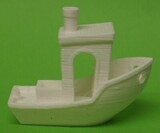6 November 2025
One step forward and two back? Had run an update on tumbleweed yesterday but when I tried to start the flatpak version of cura it failed to start. Refresh of the overnight updates fortunatly cleared the problem and I can get back into it to start to play with settings. The new springs for the levelling of the X5SA build plate are still a little light, which was the problem with the supplied ones. Buying things like this can be a pain given that sellers have no idea just what they are selling. I would prefer that I had to apply a little more pressure to compress them so they hold up the weight of a larger print, but will concentrate on smaller ones for the short term anyway.
3DBenchy is the go to starting point although I have now also found a nice Youtuber who talks about it and provides additional tuning tools which is what I am about to work my way through. I've also been running the bigger calibration model which has been running since 9PM last night and still has a little way to go on the overhang test section. That is showing up more problems than the 3DBenchy, but I think the first problem is probably speed. Even 3DBenchy takes a while to print, something around 3 hours, so I think the first step is perhaps the speed one from Teaching Tech and perhaps getting the calibration website running locally would be a start there. 3DBenchy is coming in a little small as well, so a tweak to the axis settings is also in order, or should that actually be the addition of a 'shrinkage' factor. That is something I need to distinguish between.
I'm currently running the 0.4mm nozzle with a 0.14mm layer height, so changing the layer height to speed things up is one option, but will that decrease the quality of the surface finish. Given the time these prints are taking, do I want to go down to the 0.2mm nozzle? I suspect that the 0.14mm layer height WOULD be a better combination, and also allows a drop to 0.1mm layers. Still the 3DBenchy gives a nice base to compare against.

The second pass is on the left and shows a cleaner bottom as I made a slight adjustment to the bed height between passes.

This is what happens when one uses the wrong masking tape on the bed. Need a roll of the high temperature blue stuff which is another item that has gone missing from storage.

This is actually quite a pleasing result, just took a little too long to print perhaps. A good base to build form though.

The original larger calibration model took 12.5 hours to complete, and while structurally tidy, there is a lot of stringing and poor fine detail.

Close up on the bed of the printer. Had a little fun getting it off as the masking tape was a little too good even if it's not the high temperature stuff.

Should be 100mm but 0.25mm under is close enough for me. This does throw up a question as to why 3DBenchy is somewhat smaller than it should be?

Time I think to get the macro lens out for the camera so I can focus better on the finer problems. stringing is the main problem here.

As with the 3DBenchy, I fine tuned the bed as it was printing the first layer. Need to set the dial gauge up and check just what the bowing is since it does not look like a problem with the straight edge. Using a masking tape layer does at least allow a little flexibility and protects the actual bed surface, but I think a glass bed my be on the cards for finer detail prints using the 0.2mm nozzle.

The overhang test is showing a problem I have been seeing with the other prints and watching it finish showed that the nozzle is pushing the overhang down as it prints the next layer. Is that because there is too much plastic being extruded? Certainly room for improvement in that area!
